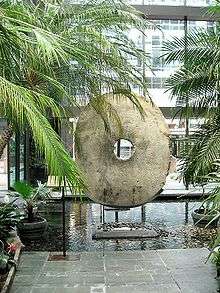Currency Museum (Canada)
 Entrance to Bank of Canada Currency Museum | |
| Established | 1980 |
|---|---|
| Location | 245 Sparks Street, Ottawa, Ontario, Canada K1A 0G9 |
| Coordinates | 45°25′15″N 75°42′11″W / 45.42088°N 75.702968°W |
| Website | The Bank of Canada Museum |
Canada's Currency Museum opened in 1980 on the ground floor of the Bank of Canada building in Ottawa. Temporarily closed in 2013 for major building renovations, the museum will reopen in a new space at the building in 2017 as The Bank of Canada Museum. The museum is the public face of the National Currency Collection, which contains over 100,000 currency-related artifacts from around the world. These include coins, bank notes, dies, plates, and engraving tools, bank and government ledgers, weights and scales, cash registers, wallets, numismatic medals and cards and examples of counterfeit money.
The National Currency Collection also encompasses a library and archive, which contain over 8,500 books, pamphlets, catalogues and journals dating back to the Middle Ages.[1]
The Museum offers various educational programs for school groups and the general public, in both English and French.[2]
History
| Part of a series on the |
| Economy of Canada |
|---|
| Economic history of Canada |
| Sectors |
|
| Economy by province |
| Economy by city |
The creation of a national currency collection was first proposed in the late 1950s by Bank Governor James Coyne.
Numismatic consultant G.R.L. Potter was hired in 1959 to help develop the collection. Under his guidance the Bank began collecting artifacts that depicted the development of Canadian currency over the previous 150 years.
By 1962 Sheldon S. Carroll had been hired as the Bank’s first Curator. Governor Louis Rasminsky directed Carroll to develop as complete as possible a collection of Canadian coins, tokens and paper money. Carroll also established collections of ancient, medieval and modern foreign currency, and of artifacts related to banking and monetary matters. The core of the Collection was assembled during this period.[3]
Artifacts were acquired from individual collectors, private-sector firms and public agencies. The collection of J. Douglas Ferguson, perhaps the best-known Canadian numismatist of his time, was purchased in 1963. This acquisition included paper money issued during the French regime, and a selection of ancient, medieval and contemporary coins.
Another significant acquisition came in 1965 with the transfer of a large collection of coins from the Public Archives of Canada. These included the Hart Collection, which had been purchased by the Canadian government in 1883.
In 1974 the Bank purchased a large collection from the Château de Ramezay, home of the Numismatic and Antiquarian Society of Montréal, Canada’s first numismatic society. This acquisition included the collection of R.W. McLachlan, Canada’s leading numismatist of the late 19th and early 20th centuries.[4]
In 1977 the Canadian Secretary of State formally designated the Bank’s acquisitions as the National Currency Collection.[5]
The Currency Museum opened its doors to the public in the newly expanded Bank of Canada Building on December 5, 1980. As of July 2, 2013, the museum will be closed for three years, while the Bank of Canada building is remodelled. When it re-opens in 2017, it will be called the Bank of Canada Museum.[6]
Affiliations
The Museum is affiliated with CMA, CHIN, and the Virtual Museum of Canada.
Additional information
Notes
- ↑ Bank of Canada 2008, p. 19
- ↑ "National Currency Museum". Bank of Canada. Retrieved 14 July 2009.
- ↑ Bank of Canada 2008, p. 20
- ↑ Bank of Canada 2008, p. 26-27
- ↑ Bank of Canada 2008, p. 27
- ↑ http://www.bankofcanadamuseum.ca/info/about/about-the-museum/new-building-project/
References
- Bank of Canada: Beads to Bytes: Canada’s National Currency Collection. 2008.
External links
- History of the earliest forms currency in Canada
- Banknotes of Canada at Will's Online World Paper Money Gallery
- Bank of Canada
- Royal Canadian Mint
